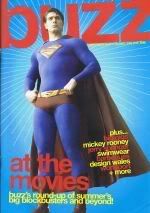Saw Week: Part VI
I think Saw VI is my favourite. Finally, everything makes sense (well, almost everything); the main story is just as engaging as the mythology stuff – and that gets an added dimension that retroactively improves the earlier movies – and it even has a serious political point to make. The editing is less distractingly awful, and the writing is as strong as in the previous two. It’s … really, really good.
That, or watching this many Saw movies in such a short space of time has utterly destroyed my brain, but I think it’s just good.
Saw VI’s centrepiece is another big maze trap, like the ones in Saw III and V. William Easton, a health insurance executive at Umbrella Health (that’s gotta be a Resident Evil reference, surely?) is an awful, smug man whose algorithm for determining individuals’ health risks has meant the death of countless people – including, indirectly, John Kramer. Jigsaw met Easton at a party (and let’s just take a moment to imagine what it would be like to get into a drunken conversation with him at a party, shall we? Urghhhhh) but he also had health insurance with Umbrella, who turned down his desperate request to be part of a Norwegian trial for an experimental cancer treatment. Tobin Bell does some amazing work in these flashback scenes; I particularly liked his “Pirahna!” non sequitur.
Anyway, Easton is a pretty nasty piece of work, which makes rooting for him almost impossible. Luckily, Saw VI’s traps are designed in a particularly cruel way: each of them requires him to choose between several people, letting some die and others live. Jigsaw wants to show him that no mathematical equation can truly measure the value of a human life, and Easton learns the lesson pretty quickly, choosing to save a middle-aged housewife over a young, healthy but unattached file clerk. These traps do sort of make a mockery of Jigsaw’s idea that everyone should get the chance to make a choice between life and death for themselves, since in several of the traps – particularly the carousel – not everyone can survive, no matter what. That’s the first time that’s happened, since in all of Jigsaw’s previous traps (not Amanda’s rigged ones) there’s always been the possibility that everyone can survive. But since all of these people are Easton’s employees, mostly his most heartless favourites who spend their working lives trying to find reasons to deny people the healthcare they so desperately need, it’s difficult to feel too much sympathy for them. And since this is Jigsaw’s final game, we’ll just have to cut him a bit of slack.
At the end of William’s maze, there are two cages: one containing Pamela Jenkins, a journalist we briefly glimpsed at a press conference in Saw V, and the other Tara and her teenaged son Brent. Without spoiling the twist too much, the end of Saw VI is another exercise in showing us not to make assumptions, ever. It’s kind of similar to the twist at the end of Saw III, really, but even more effectively executed.
Outside the trap, the police are closing in on Hoffman. Special Agent Perez, Strahm’s partner, turns out to have survived the injuries she suffered back in Saw IV, and she doesn’t believe that Strahm was Jigsaw’s accomplice. The tape Hoffman made in his first trap (the unwinnable pendulum game) is being analysed by a techie who unscrambles the distortion on the voice and reveals … Hoffman! Sadly, he’s in the room when that happens, and wastes no time in killing Perez for real, along with Erickson and the hapless tech. (A particularly nice touch: the soundbite that’s being unscrambled is “right now you’re feeling helpless”, and it plays over and over again during the scene where Perez confronts Hoffman. It’s maybe a little heavy-handed, but at this point, it really works.)
Revelation is piled on top of revelation as the final pieces of the story start to slot into place: Jill Tuck has been in on Jigsaw’s schemes since at least Saw III, if not earlier; Hoffman and Amanda were always jealous of one another and constantly jockeyed for position in Jigsaw’s affections; and most devastatingly, it emerges that Amanda was with Cecil, the junkie who caused Jill to miscarry Jigsaw’s child, on that fateful night - and Hoffman used that information to blackmail her, forcing her into failing her final test in Saw III. That last revelation at least partially redeems Amanda, changing the franchise’s treatment of her; she wasn’t just stupid after all, she was just a woman whose life took a really, really bad turn. Her desperation for John’s approval was her undoing, finally, but it wasn’t just because she was an idiot, or evil. Saw VI makes her more tragic, but also more sympathetic. It feels like a more dignified ending for her character than the previous one, and I’m really glad it happened.
It’s interesting: over the last couple of films, the new writing team have created a weird nuclear family for Jigsaw where Jill and John are the parents and Mark and Amanda are the squabbling kids. It’s perverse and twisted and … weirdly moving. Like any long running horror franchise, the villain eventually becomes the point, the one consistent element through all the films that, despite their undeniably evil intentions, the audience can’t help but sympathise with, at least a little bit. No-one remembers the eighth person Freddy Kruger murdered, or who Jason kills in Friday the 13th Part 5: A New Beginning, but Freddy and Jason are indelibly burned into our brains. Jigsaw slots effortlessly into the canon, but he’s exponentially more nuanced than any of the other mass murdering horror icons out there. We can’t entirely identify with him, or condone his actions fully, but there’s a sense there that, on some level, what he’s doing makes sense. It’s vigilante justice that he dispenses, but it’s not madness without method.
The final moments of Saw VI bode well for Saw VII: as Hoffman completes Jigsaw’s final game, he finds himself thrown into his own test, as Jill carries out the final instruction John left for her. Will he pass or fail the test? What’s the lesson Jigsaw needs him to learn – and will he learn it, or will he ignore it like so many of the other things John tried to teach him?
The attention to detail is probably my favourite thing about Saw VI, and it’s what gives me hope for Saw VII. There’s a particularly jaw-dropping bit of coffee cup continuity in Saw VI that’s so nerdy I wanted to stand and applaud, and the tiny, almost insignificant detail about Hoffman using an inferior kind of blade in Saw V that leads to his undoing in Saw VI is bloody beautiful. I’m simultaneously really excited to see Saw VII/3D, and terrified. I want it to be a fitting end to this franchise that I’ve somehow, unexpectedly, come to really love; I’m afraid that it’ll get too caught up with doing crazy 3D stunts to deliver the in-depth character exploration I crave. 3D has the same writing team and director as VI, which I’m hoping means it’ll be as good. Oh, please let it be as good.











4 comments:
Ok, so I'm rly confused as to when Jigsaw actually dies and who is carrying on his instructions. Maybe I need to watch them all too? ;)
Yes. Yes you do. Allllll the movies!
I just watched this for the first time this evening. It was a LOT better than I expected it to be, and it was nice to see everyone's favorite trap (TM) make an appearance. I agree with you about Amanda; this installment really helped her character out a lot.
It's my favourite Saw film by a long shot! I'm still disappointed by how awful Saw VII/3D/The Final Chapter was, too. UGH.
Post a Comment